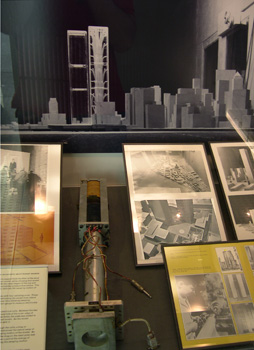
The World Trade Center was the first skyscraper design to be tested in a boundary layer wind tunnel, which replicates natural wind. Air flow around tall buildings creates turbulence and eddies that can cause vibration or sway. These effects can be accurately predicted by three kinds of tests. Special highly accurate models are built to represent the building’s form and nearby surroundings, often at a scale of 1:400.
A “pressure tap” model, as in the lower large photograph in this case, measures local pressures on the facade using hundreds of tiny tubes, or taps, connected to a computer.
A “force balance” model measures overturning of the entire building as wind gusts strike randomly.
An “aeroelastic” model, as in the upper large photograph in this case, also measures overturning, but includes the effect of the natural rate of rhythmic rocking back and forth, known as the building’s period.
From these studies, the engineers were able to analyze and predict the definition of both the steady-state and the fluctuating wind pressures on the facade; the steady-state and dynamic behavior of a tall building in turbulent wind; and a quantification of the increase in street-level winds associated with the construction of a high-rise building. They also developed a new theory of the prediction of the breakage rate of glass subjected to the natural winds of the atmosphere.
While now standard practice in the technology of high-rise design, the pioneering effort for the World Trade Center required significant reconstruction of laboratory facilities. Ultimately, three different wind tunnels at three different labs were used: one in the United States (Colorado State University), one in the United Kingdom (National Physical Laboratory, Teddington), and one in Canada (The University of Western Ontario).
| Les Robertson: Considering the Wind |
 2006 The Skyscraper Museum. |